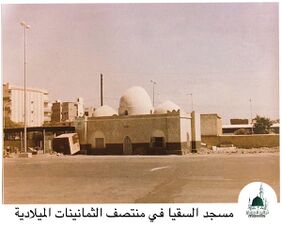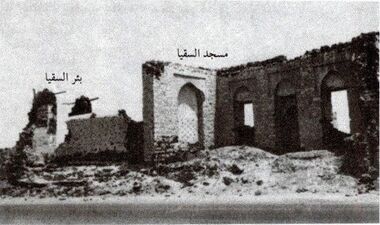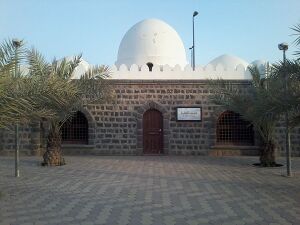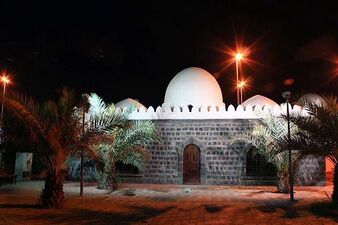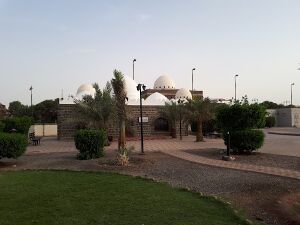Al-Suqya Mosque
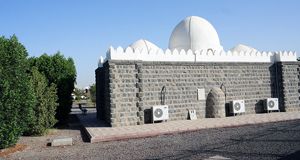 | |
| General Information | |
|---|---|
| Other Names | Al-Ru'us Mosque |
| Place | Medina, inside the area of al-'Anbariyya train station |
| Usage | Mosque |
| History | |
| Events | Prayer of the Prophet Muhammad(a) when he was going to Badr |
| Current State | |
| Status | Active |
Al-Suqya Mosque (Arabic: مسجد السقیا) is one of the mosques in Medina, which is located in the southeast part of Medina railway station, in al-'Anbariyya neighborhood. This mosque is called al-Suqya; because it is located in the al-Suqya region near al-Suqya well. On the way to Battle of Badr, the Prophet saw his army in Suqya, did his prayer, prayed for the people of Medina, and drank water from the well of al-Suqya.
Location
Al-Suqya Mosque is located inside the fence of al-'Anbariyya railway station and in its southeast. The well of al-Suqya is located in the south of that mosque, and Tariq Makka Street separates the two (the well and the mosque).[1] Currently, al-Suqya Mosque is inside the railway station.[2]
Name
This mosque is called al-Suqya; because it is located in the al-Suqya region and near al-Suqya well.[3]
Qubbat al-Ru'us
From the 11th/16th century onwards, this mosque was also known as the Qubbat al-Ru'us.[4] According to 'Ali Hafiz, it was called Qubbat al-Ru'us because Ottoman Turks used to cut off the heads of desert bandits and put them there.[5] Al-'Ayyashi, the historian of Medina, believes that this name has a bad effect and is not worthy of this mosque.[6]
The Prophet(a) in al-Suqya
On the way from Medina to the Battle of Badr, the Prophet Muhammad(a) stopped in al-Suqya and did prayer and prayed: just as God blessed the people of Mecca after the prayer of the Prophet Abraham(a), may He also bless the people of Medina.[7] It is said that the Prophet saw his army in this place.[8] It is reported that the Prophet(a) drank water from the al-Suqya well on his way to Badr.[9]
History
Ibn Shabba considers this mosque one of the mosques where the Prophet(a) has prayed.[10] According to al-Samhudi's report, 'Umar b. 'Abd al-'Aziz built this mosque at the place of the Prophet's prayer. According to the words of al-Samhudi, quoting Abu 'Abd Allah al-Asadi, one of the historians of the first centuries, this mosque was famous as one of the historical mosques of Medina.[11]
Al-Samhudi's Report
At the time of al-Samhudi, this mosque was destroyed. He went to the place of the mosque and saw a big building stone, he ordered to dig there. After the exploration, the mihrab and the four corners of the al-Suqya Mosque appeared. Based on the decorations and carvings of the stones that were discovered, al-Samhoudi believed that this building was built during the time of 'Umar b. 'Abd al-'Aziz.[12] According to al-Samhudi's report, al-Suqya Mosque in his time, was rebuilt on its original foundations, which is a square with an area of about seven cubits by seven cubits.[13] Ahmad al-'Abbasi's report in the 11th/17th century also confirms the area of this mosque.[14] According to a report from 1073/1662-3 this mosque is located on the left side of the road leading to Medina from 'Aqiq route, in the western harra.[15]
Yasin al-Khayari's opinion
Scholars of the first and middle centuries agree that the al-Suqya Mosque is a historical mosque inside the railway station today. Yasin Al-Khayari a contemporary historian of Medina, said that the ruined building that was located next to the al-Suqya well in his time and was destroyed for the development of the road, is the al-Suqya Mosque.[16] This dilapidated building is visible in the picture he gave in his book. Muhammad 'Ilyas Abd al-Ghani, has proved the famous opinion and rejected the opinion of al-Khayari providing several reasons.[17]
Description
Al-Shanqiti describes the al-Suqya Mosque as follows, inside the buildings of the railway station, from the south, the al-Suqya Mosque can be seen, which has triple domes. The middle dome is bigger.[18]
Its mihrab is on the Qibla wall. In half of the north, east, and west walls of the building, arched and crescent-shaped windows are installed. The walls are covered with white plaster.[19]
Gallery
-
The old picture of Suqya Mosque from the 80s.
-
The old picture of Suqya Mosque from the 80s.
-
The picture of the destroyed building, attributed to the Suqya Mosque in the book Tarikh ma'alimal-madina al-munawwara, p. 149.
-
The picture of Suqya Mosque after Rebuilding.
-
The picture of the mihrab of Suqya Mosque.
Notes
- ↑ Anṣārī, Āthār al-Madīna al-munawwara, p. 136.
- ↑ Jaʿfarīyān, Āthār-i Islāmī-yi Makka wa Madīna, p. 367.
- ↑ ʿAbd al-Ghanī, Al-Masājid al-atharīyya, p. 102.
- ↑ Anṣārī, Āthār al-Madīna al-munawwara, p. 136.
- ↑ Ḥāfiẓ, Fuṣūl min tārīkh al-Madīna al-munawwara, p. 146; Anṣārī, Āthār al-Madīna al-munawwara, p. 136.
- ↑ ʿAyyāshī, al-Madīna al-munawwara bayn al-māḍī wa l-ḥāḍir, p. 192.
- ↑ Tirmidhī, al-Jāmiʿ al-ṣaḥīḥ, vol. 5, p. 528.
- ↑ Numayrī, Tārīkh al-Madīna al-munawwara, vol 1., p. 72.
- ↑ Ibn Saʿd, al-Ṭabaqāt al-kubrā, vol. 1, p. 504.
- ↑ Numayrī, Tārīkh al-Madīna al-munawwara, vol. 1, p. 72.
- ↑ Samhūdī, Wafāʾ al-wafā, vol. 3, p. 198.
- ↑ Samhūdī, Wafāʾ al-wafā, vol. 3, p. 200.
- ↑ Samhūdī, Wafāʾ al-wafā, vol. 3, p. 200.
- ↑ ʿAbbāsī, ʿUmdat al-akhbār, p. 189.
- ↑ ʿAyyāshī, al-Riḥla al-ʿAyyāshīyya, vol. 1, p. 395.
- ↑ Khayārī, Tārīkh maʿālim al-Madīna al-munawwara, p. 149.
- ↑ ʿAbd al-Ghanī, Al-Masājid al-atharīyya, p. 102-106.
- ↑ Shanqīṭī, al-Durr al-thamīna fī maʿālim dār al-Rasūl(s), p. 237.
- ↑ Ṣāliḥ Lumaʿī, al-Madīna al-munawwara taṭawwurihā l-ʿumrānī wa turāthiha al-miʿmārī, p. 209-210.
References
- ʿAbbāsī, Aḥmad b. ʿAbd al-Ḥamīd. ʿUmdat al-akhbār. Medina: al-Maktab al-ʿIlmīyya, [n.d].
- ʿAbd al-Ghanī, Muḥammad Ilyās. Al-Masājid al-atharīyya fī l- Madīna al-munawwara. Medina: [n.p], 2000.
- Anṣārī, ʿAbd al-Quddūs al-. Āthār al-Madīna al-munawwara. Medina: Maktabat al-Salafīyya, 1973.
- ʿAyyāshī, ʿAbd Allāh b. Muḥammad al-. Al-Riḥla al-ʿAyyāshīyya. Abu Dhabi: Dār al-Suwaydī, 2006.
- ʿAyyāshī, Ibrāhīm al-. Al-Madīna al-munawwara bayn al-māḍī wa l-ḥāḍir. Medina: al-Maktab al-ʿIlmīyya, 1972.
- Ḥāfiẓ, ʿAlī. Fuṣūl min tārīkh al-Madīna al-munawwara. Jeddah: Shirka al-Madīna al-Munawwara, 1417AH.
- Ibn Saʿd, Muḥammad b. Manīʿ al-Ḥāshimī al-Baṣrī. Al-Ṭabaqāt al-kubrā. Edited by Muḥammad ʿAbd al-Qādir ʿAṭāʾ. Beirut: Dār al-Kutub al-ʿIlmīyya, 1410/1990.
- Jaʿfarīyān, Rasūl. Āthār-i Islāmī-yi Makka wa Madīna. Tehran: Mashʿar, 1382Sh.
- Khayārī, Sayyid Aḥmad Yāsīn al-. Tārīkh maʿālim al-Madīna al-munawwara qadīman wa ḥadīthan. Riyadh: al-Amāna al-ʿĀmma li-l-iḥtifāl miʾat ʿām ʿalā l-taʾsīs al-mamlakat al- ʿArabīyya al-Suʿūdīyya, 1419/1999.
- Numayrī, Ibn Shabbah al-. Tārīkh al-Madīna al-munawwara. Edited by Fahīm Muḥammad Shaltūt. Tehran: Mashʿar, 1380Sh.
- Ṣāliḥ Lumaʿī, Muṣṭafā. Al-Madīna al-munawwara taṭawwurihā l-ʿumrānī wa turāthiha al-miʿmārī. Beirut: Dār al-Nihḍa al-ʿArabīyya, 1981.
- Samhūdī, ʿAlī b. ʿAbd Allāh al-. Wafāʾ al-wafā bi-akhbār dar al-Muṣṭafā. Edited by Muḥammad Muḥyi l-Dīn ʿAbd al-Ḥamīd. Beirut: 1984.
- Shanqīṭī, Muḥammad al-Amīn al-. Al-Durr al-thamīna fī maʿālim dār al-Rasūl(s). Beirut: Muʾassasat ʿUlūm al-Qurʾān, 1411AH.
- Tirmidhī, Muḥammad b. ʿĪsā al-. Al-Jāmiʿ al-ṣaḥīḥ. Cairo: Dār al-Ḥadīth, 1419AH.

